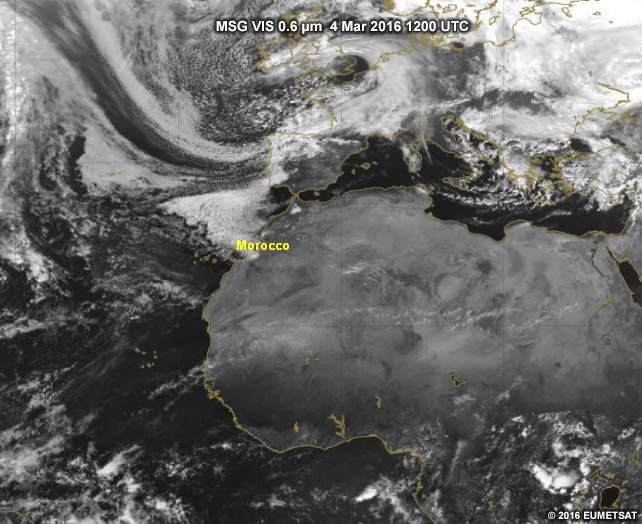Contributions of Each Product
The WV, IR, VIS and airmass RGB products are all useful for identifying the jet. They provide users with the ability to view and analyze a variety of features such as clouds connected to jet stream to detect the jet axis In the questions below, decide what information you used in each product to identify the jet.

Question 1
What information helped you identify the jet in the WV imagery?
The correct answers are A, B, and D.
To locate the jet stream in WV imagery, we look for areas with contrasting dark (dry) and light (moist) gray shades. The subsidence of dry stratospheric air results in dark streaks on the poleward side of the jet axis and in strong moisture gradients across the jet stream. This makes options A, B and D correct. Option C is incorrect because the dark stripes in the WV imagery are parallel, not perpendicular, to the jet and usually found on its cyclonic side. Option D is incorrect because the area of strong gradient of the dynamical tropopause heights produces sharp boundary between stratospheric (dry) and tropospheric (moist) air. This limit is also aligned with the area of the jet stream.
Question 2
What information helped you identify the jet in the airmass RGB?
The correct answers are A and D.
Option A is correct since dry descending stratospheric air related to an advection jet appears in reddish colours in the airmass RGB. Option B is incorrect because jet streams are associated with an upper tropospheric anomaly of high PV advected down to middle troposphere, this stratospheric intrusion called PV anomaly or low tropopause area. Option C is incorrect because high clouds associated with the jet stream are white in the airmass RGB, not red. Option D is correct because the airmass RGB image contains information from the WV channel. This enables it to show dynamic features of the atmosphere, such as deformation zones, jet streams, and PV anomalies. It provides information primarily about the middle and upper levels of the troposphere, not the lower levels and near-surface conditions.
Question 3
What information helped you identify the jet in the IR imagery?
The correct answer is A.
Option A is correct because the presence of the cirrus band with elongated features indicates turbulent flow within the jet stream. Option B is incorrect because the jet clouds show fibrous structures but appear very bright, light grey or white in both the IR and WV images. Option C is incorrect because a jet fiber appears whiter than the rest of the frontal cloud band.
Question 4
What information helped you identify the jet in the VIS imagery?
The correct answer is C.
Option A is incorrect because cirrus clouds are often quite transparent and have low albedo. Option B is incorrect because high clouds, particularly cirrus, are thin and semi transparent, and have low albedo. This makes them difficult to distinguish in visible imagery. Finally, option C is correct because visible imagery, in particular high resolution visible imagery, can be highly beneficial for identifying fine-scale cloud features within jet streams like this.